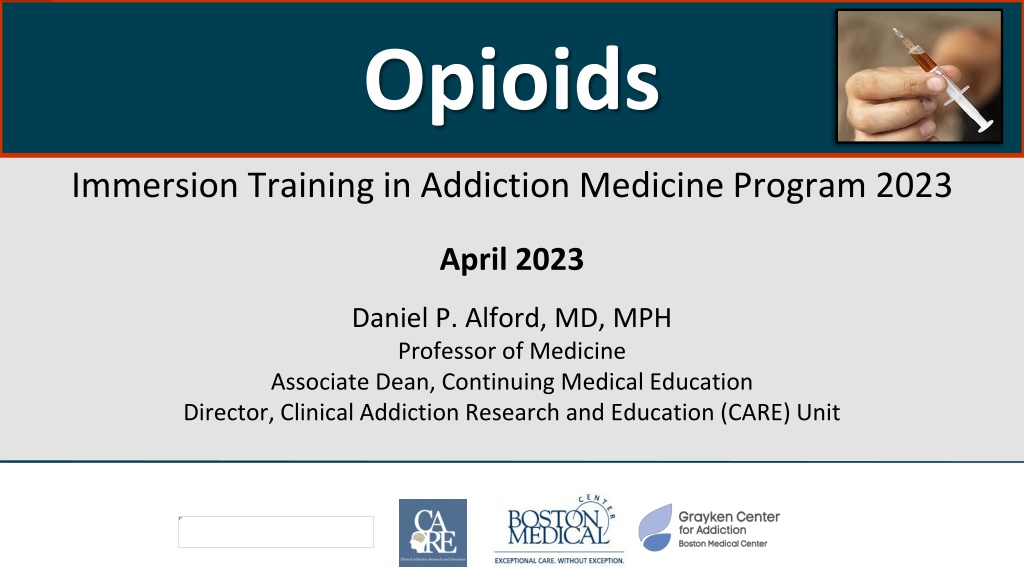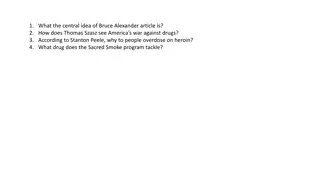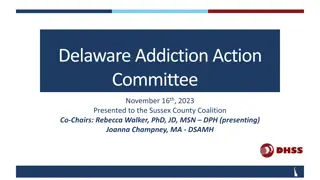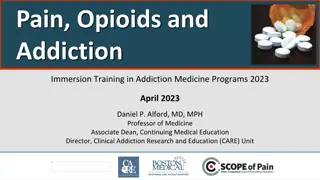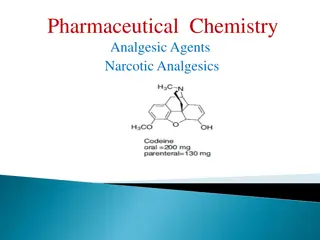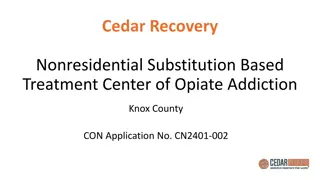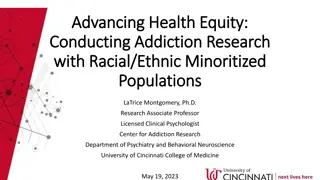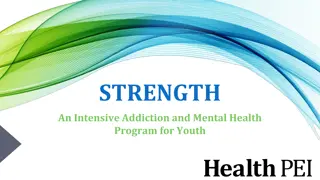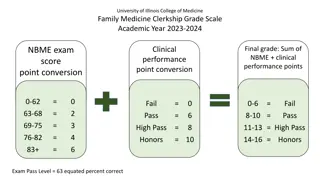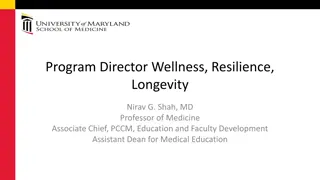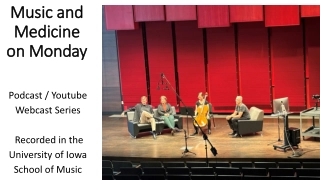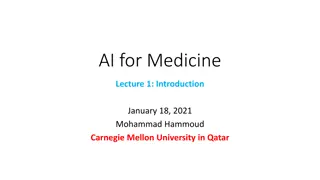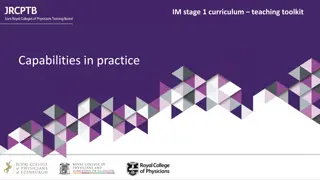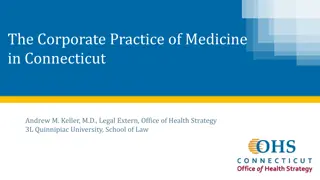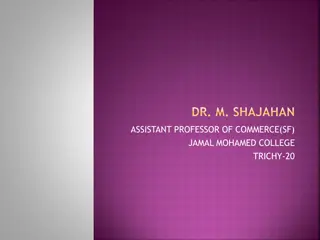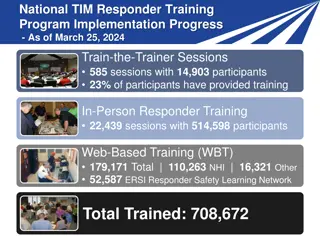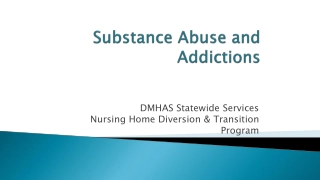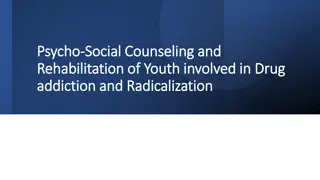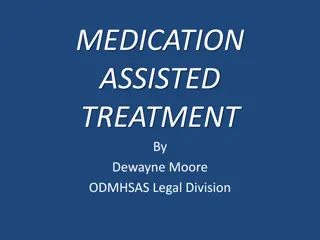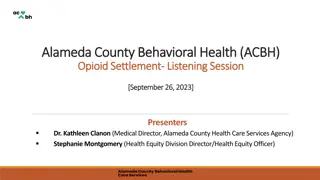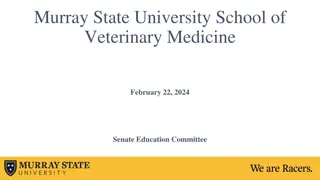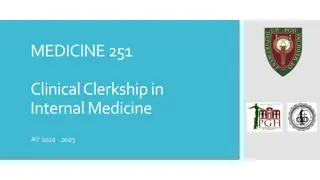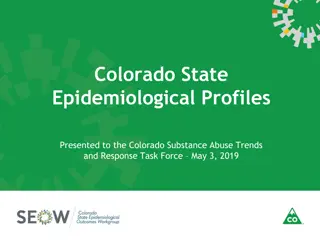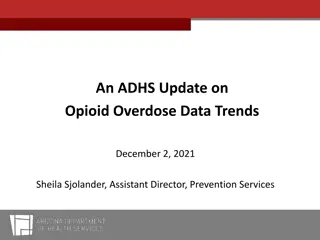Opioids Immersion Training in Addiction Medicine Program 2023
Opioids Immersion Training program led by Dr. Daniel P. Alford focuses on addiction medicine, including real case scenarios like opioid overdoses and the changing illicit opioid supply. The program addresses the natural history of opioid use disorder and the complexities of treating patients with opioid use disorder, providing insights into assessment and treatment approaches.
Download Presentation

Please find below an Image/Link to download the presentation.
The content on the website is provided AS IS for your information and personal use only. It may not be sold, licensed, or shared on other websites without obtaining consent from the author. Download presentation by click this link. If you encounter any issues during the download, it is possible that the publisher has removed the file from their server.
E N D
Presentation Transcript
Opioids Immersion Training in Addiction Medicine Program 2023 April 2023 Daniel P. Alford, MD, MPH Professor of Medicine Associate Dean, Continuing Medical Education Director, Clinical Addiction Research and Education (CARE) Unit
Case 32-year-old male brought into the Emergency Department after an opioid overdose Brisk response to naloxone Re-sedation after 1 hour requiring repeat naloxone Antecubital abscess and cellulitis at injection site Admitted for drug overdose , persistent altered mental status and arm cellulitis (?abscess)
Opioid Overdose Deaths Whites with multiple periods of acceleration 1999 to 2016 with decrease rate of change 2016 to 2018 African Americans: low rate of change 1999-2012 followed by rapid acceleration (intro of illicit fentanyl) From 2013 2018 average annual precent change significantly higher in African Americans than Whites Opioid crisis has focused white, middle- class, suburban and rural users, the impact in African American communities has been unrecognized Furr-Holden D et al. Addiction. 2020
The Illicit Opioid Supply is Changing DEA National Drug Threat Assessment. March 2021
Natural History of Opioid Use Disorder Euphoria Tolerance Withdrawal Normal Physical Dependence Chronic use Initial use Alford DP. http://www.bumc.bu.edu/care/
Case continued Substance use history Daily heroin/fentanyl use Intranasal use for 6 months then IV for 7 years History of 2 overdoses Had been in recovery for 2 years by going to NA but relapsed 3 months ago History of 10 detox s, no treatment with medications No other drug, alcohol or tobacco use HIV and hepatitis C negative Unemployed electrician Lives with wife (in recovery) and 2 young children Now complaining of arm pain and opioid withdrawal How will you assess and treat him?
Opioid Use Disorder Complex Provider/Patient Experience Study conducted on the inpatient medical service of a public urban teaching hospital Qualitative analysis on the interactions with illicit opioid-using patients and their medical teams identified 4 common themes Merrill JO, et al. J Gen Intern Med. 2002
Provider Perspective 1. Physician Fear of Deception Physicians question the legitimacy of need for opioid analgesics ( drug seeking patient vs. legitimate need). All of us go through a little bit of a hitch every time we are requested to prescribe narcotics for our patients....Are they trying to get more out of me than they really should have? The last thing I want to do is over-dose them or reinforce this behavior (of) trying to coax more drugs out of you. -Senior Medical Resident Merrill JO, et al. J Gen Intern Med. 2002
Patient Perspective 2. No Standard Approach The evaluation and treatment of pain and withdrawal is extremely variable among physicians and from patient to patient. There is no common approach nor are there clearly articulated standards. The last time, they took me to the operating room, put me to sleep, gave me pain meds, and I was in and out in two days.. . .This crew was hard! It s like the Civil War. He s a trooper, get out the saw . . . -Patient w/ Multiple Encounters Merrill JO, et al. J Gen Intern Med. 2002
Patient Perspective 3. Avoidance Physicians focused primarily on familiar acute medical problems and evaded more uncertain areas of assessing or intervening in the underlying addiction problem- particularly issues of pain and withdrawal. Patient/Resident Dialog Resident: Good Morning Patient: I m in terrible pain. Resident: This is Dr. Attending, who will take care of you. Patient: I m in terrible pain. Attending: We re going to look at your foot. Patient: I m in terrible pain. Resident: Did his dressing get changed? Patient: Please don t hurt me. Merrill JO, et al. J Gen Intern Med. 2002
Patient Perspective 4. Patient Fear of Mistreatment Patients are fearful they will be punished for their drug use by poor medical care. I mentioned that I would need methadone, and I heard one of them chuckle. . .in a negative, condescending way. You re very sensitive because you expect problems getting adequate pain management because you have a history of drug abuse. . .He showed me that he was actually in the opposite corner, across the ring from me. -Patient Merrill JO, et al. J Gen Intern Med. 2002
Opioid Withdrawal Assessment Grade Symptoms / Signs 0 Anxiety, Drug Craving 1 Yawning, Sweating, Runny nose, Tearing eyes, Restlessness Insomnia Dilated pupils, Gooseflesh, Muscle twitching & shaking, Muscle & Joint aches, Loss of appetite 2 Nausea, extreme restlessness, elevated blood pressure, Heart rate > 100, Fever 3 Vomiting / dehydration, Diarrhea, Abdominal cramps, Curled-up body position 4 Clinical Opiate Withdrawal Scale (COWS):pulse, sweating, restlessness & anxiety, pupil size, aches, runny nose & tearing, GI sx, tremor, yawning, gooseflesh (score 5-12 mild, 13-24 mod, 25-36 mod severe, 36-48 severe)
Inpatient Goals Prevent/treat acute opioid withdrawal Inadequate treatment may prevent full treatment of medical/surgical condition Don t expect to cure OUD during hospitalization Withholding opioids will not cure patient s OUD Administering opioids will not worsen patient s OUD Initiate addiction treatment referral Diagnose and treat medical illness Growing evidence that medications for OUD facilitates the treatment of other serious complications of OUD e.g., endocarditis and osteomyelitis (Jo Y, et al. Addiction. 2021)
Inpatient Treatment of Opioid Withdrawal Methadone Start w/ 20 mg po Reassess q 2-3 h, give additional 5-10 mg until withdrawal signs abate Don t exceed 40 mg/24 hrs Buprenorphine Start with 2-4 mg SL (or low dose: 0.5 mg SL, 20 mcg/hr TD patch, 150-450 mcg buccal) Reassess q 2-3 h, give additional 4 mg until withdrawal signs abate Don t exceed 16 mg/24 hrs Authorized hospital staff [may] administer narcotic drugs in a hospital to maintain or detoxify a person as an incidental adjunct to medical or surgical treatment of conditions other than addiction (Code of Federal Regulations title 21, up to date as of 4/20/2023) Monitor for response and CNS and respiratory depression Give same dose each daily including day of discharge Cannot give a methadone prescription at time of discharge Peterkin A et al. Med Clin N Am. 2022 Sokolski E et al. J Addict Med. 2023 Cohen SM et al. J Addict Med. 2022 Can give a buprenorphine prescription at time of discharge
Case continued Hospital course Arm abscess I and D, cellulitis treated with IV Vancomycin Opioid withdrawal management included methadone 30 mg during his hospital course He did not want to remain on medication (methadone or buprenorphine) for his OUD at the time of discharge 6 months later He presents to your primary care clinic requesting referral to detox for his opioid use disorder He has been using heroin/fentanyl since the day he left the hospital
Opioid Detoxification Outcomes Low rates of retention in treatment High rates of relapse post-treatment < 50% abstinent at 6 months < 15% abstinent at 12 months Increased rates of overdose due to decreased tolerance O Connor PG JAMA 2005 Mattick RP, Hall WD. Lancet 1996 Stimmel B et al. JAMA 1977
Reasons for Relapse Protracted abstinence syndrome Secondary to derangement of endogenous opioid receptor system Symptoms Generalized malaise, fatigue, insomnia Poor tolerance to stress and pain Opioid craving Conditioned cues (triggers) Priming with small dose of drug
Medications for OUD (MOUD) Treatment Goals Suppress opioid withdrawal* Opioid blockade Alleviate drug craving Normalized brain changes Options *Opioid Agonist Therapy (OAT) Methadone (full agonist) Buprenorphine (partial agonist) Naltrexone (full antagonist) Peterkin A et al. Med Clin N Am. 2022
Naltrexone Pure opioid antagonist Patients physically dependent must be opioid free for at least 7-10 days before treatment Oral naltrexone (daily) Well tolerated, safe, duration of action 24-48 hours No statistically significant difference compared to placebo due to poor retention(Minozzi S et al. 2011) More effective than placebo when patients legally mandated to take it Injectable XR naltrexone (monthly) IM w/ customized needle, administered by healthcare provider Increased abstinence (90% vs 35% [Krupitsy E, et al. Lancet, 2011]) Poor retention (40% at 3 months, <10% at 6 months [Cousins SJ et al. J Sub Abuse Treat 2016])
Methadone Methadone Full opioid agonist PO onset of action 30-60 minutes Duration of action 24-36 hours to treat OUD Proper dosing for OUD 20-40 mg for acute withdrawal > 80 mg for craving, opioid blockade Opioid Treatment Program Highly structured Observed daily Take homes
Extensive Research on Effectiveness JAMA 1965 Increases treatment retention Decreases illicit opioid use Decreases hepatitis and HIV seroconversion Decreases mortality Decreases criminal activity Increases employment Improves birth outcomes
Methadone Maintenance Limitations Highly regulated - Narcotic Addict Treatment Act 1974 Limited access Inconvenient and highly punitive Mixes stable and unstable patients Lack of privacy No ability to graduate from program Stigma
Buprenorphine Semi-synthetic analogue of thebaine FDA approved 2002 as schedule III up to 5 refills Ceiling effect on CNS and respiratory depression Mu-opioid receptor partial agonist Kappa-opioid receptor antagonist (antidepressant and anxiolytic effects) Formulations: sublingual tab and film combined with naloxone, monthly SQ injection (administered by healthcare provider only)
Buprenorphine Waiver not required to prescribe buprenorphine for OUD No limits on number of patients that a prescriber may treat for OUD with buprenorphine
Buprenorphine Efficacy Summary Studies (RCT) show buprenorphine (16-24 mg) more effective than placebo and equally effective to moderate doses (80 mg) of methadone on primary outcomes of: Retention in treatment Abstinence from illicit opioid use Decreased opioid craving Decreased mortality Improved occupational stability Improved psychosocial outcomes Sordo L et al. BMJ 2017 Mattick RP et al. Conchrane Syst Rev 2014 Parran TV et al. Drug Alcohol Depend 2010 Johnson et al. NEJM 2000 Fudala PJ et al. NEJM 2003 Kakko J et al. Lancet 2003
Barriers to Use of MOUD Delay between OUD onset and MOUD receipt 4-7 years Blacks have less than half the odds of initiating MOUD than Whites Stigma toward drug addiction, individuals with OUD, and the medications to treat it Inadequate education of health professionals National Academies of Sciences, Engineering, and Medicine. 2019. The National Academies Press.
MOUD after Opioid Overdose Data from multiple Massachusetts administrative systems (2011-2015) Retrospective cohort of overdose survivors (N=17,568) For the 12 months after the index overdose only 17% received buprenorphine, 11% received methadone, and 6% received naltrexone Compared with no MOUD, receipt of buprenorphine or methadone was associated with a two-thirds reduction in death (all-cause and opioid- related mortality) Larochelle MR , et al. Ann Intern Med. 2018
Starting MOUD Wherever Patients Present Inpatient Service Compared with an inpatient detox, initiation of and linkage to buprenorphine treatment is effective for engaging hospitalized patients who are not seeking addiction treatment and reduces illicit opioid use after hospitalization (Liebschutz JM et al. JAMA Intern Med. 2014) Patients receiving inpatient MOUD were mostly white, non-Hispanic. Receipt of MOUD resulted in significant reductions in LOS and readmission rates (O Rourke BP et al. Drug Alc Depend. 2022) Emergency Department ED-initiated buprenorphine vs brief intervention/referral significantly increased engagement in addiction treatment, reduced self-reported illicit opioid use (D Onofrio G et al. JAMA. 2015) Despite high fentanyl prevalence, the incidence of precipitated withdrawal in ED-initiated buprenorphine (8-12 mg) was < 1%, similar to rates among those using heroin or prescription opioids (D Onofrio G et al. JAMA Network Open. 2023)
Transitions of Care Systematic review on interventions for optimizing transitions in care from hospital to community for individuals with a SUD 31 studies including 7 RCTs and 24 quasi-experimental designs which focused on opioid use (n = 8), alcohol use (n = 5), or polysubstance use (n = 18) Interventions included pharmacotherapy initiation (n = 7), addiction consult services (n = 9), protocol implementation (n = 3), SBIRT (n = 2), patient navigation (n = 4), case management (n = 1), and recovery coaching (n = 3) Both pharmacologic and psychosocial interventions improved engagement in care and reduce hospital readmission and ED presentations James H et al. Drug Alc Depend 2023
Bridge Clinics On-demand access to MOUD Low-barrier, transitional SUD treatment models (outpatient hospital-based, EM-based, virtual) Non-OTP providers administer methadone for up to 72 hours while arranging OTP linkage (Taylor JL et al. Drug Alc Depend. 2022) Harm reductions service integration overdose education, naloxone, safer injection and smoking materials, lower barrier STI, viral hepatitis, HIV screening, treatment, prevention including POC rapid HIV testing, PrEP, PEP, wound care, contraceptive services Data on effectiveness in linking to long-term care are limited Taylor JL, et al. Addiction Science & Clinical Practice. 2023 (narrative review)
Treatment Retention with MOUD National data of commercially insured individuals 14,358 initiated MOUD 85% SL buprenorphine 8% XR naltrexone 6% methadone 1% XR buprenorphine Treatment discontinuation rates (3m) 34% SL buprenorphine 50% XR buprenorphine 58% methadone 65% XR naltrexone Morgan JR, et al. Drug Alcohol Depend. 2021
Periop Pain Management in Patients Taking Methadone or Buprenorphine Patients with an OUD are more sensitive to painful stimuli Continue methadone or buprenorphine throughout the perioperative period Treat pain with analgesics on top of the patients daily MOUD Opioid analgesic requirements are often higher due to increased pain sensitivity and opioid cross tolerance Ineffective pain management can result in disengagement of care Hickey T et al. Med Clin N Am. 2022 Veazie S et al. J Gen Intern Med. 2020 Kohan L et al. Reg Anesth Pain Med. 2021 Alford DP, Compton P, Samet JH. Ann Intern Med 2006
